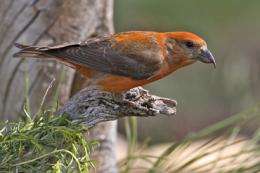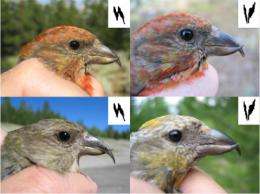The red crossbills of North America have seven different beaks adapted to different kinds of pinecones, and seven different "contact calls" to indicate which sub-species they belong to. Credit: Alan Wilson
(PhysOrg.com) -- A male bird uses his songs as pick-up lines. They're a way of saying, "Hey baby, come check me out."
Fortunately for the females, such songs are only a small selection of bird talk. Other calls, sounding alarm or excitement, are much more critical to survival and make up more of a birds' everyday chirping. Four different crossbill subspecies, with graphic traces of how their contact calls vary. Credit: Kendra Sewall.
Few scientists study birds' non-mating calls. But Duke post-doctoral researcher Kendra Sewall does, and she says that studying the entire repertoire of bird calls could tell us even more about human disorders like schizophrenia and autism, which are marked by difficulty processing language and social behavior.
By studying how a bird does or does not correctly perceive, process or respond to the calls it uses to survive, scientists may be able to learn more about where abnormal signal processing in humans originates, Sewall says.
She presented her work at a May 24 American Scientist lecture and lunch in the Research Triangle Park.
Crossbills are unique in that they are the North American version of Darwin's finches, Sewall says. Over time, the birds have evolved into seven sub-species or "races" based on body size and beak structure. While the birds' genetics are not yet so different to mark the races as distinct species, each race's beak structure is adapted to crack open a specific pinecone so the bird can eat the seeds.
In other words, if a crossbill flies with a flock of the wrong race, it could starve, or at the very least, not be able to mate.
Scientists wondered how crossbills stayed with the right race to visit the right trees. Observing crossbills in the wild, it became clear that the contact call for each race is distinct. The calls have acoustic signatures, or dialects, that distinguish the races, and a crossbill will modify its dialect further, almost like adding an accent, to match a call with its mate.
For her doctoral research, she captured 42 crossbills and paired them in cages in a lab to see how they match their accents. Some of the pairs were males and females of the same race, using the same dialect, while other pairs were males and females from different races and dialects.
In pairs of the same race, Sewall observed that the birds would chirp back and forth until their contact call converged on the same sound. Both males and females tweaked their contact call subtly to imitate and match the calls of their mate, flock and family members.
That was surprising because it's usually only the male birds that change their songs and calls, Sewall says.
In the mixed pairs, she also observed that both males and females changed their calls. But, in some of these mixed pairs, males and females would chirp back and forth, until their contact calls diverged rather than agreeing.
Observing the birds' ability to change their calls, Sewall became curious about the brain processes underlying animal communication, such as perception, motivation and vocal response. These processes determine both adaptive social behaviors and abnormal or dysfunctional ones.
She says by studying the brain and hormone systems that influence the animals' motivations to engage in making contact calls and other social interactions, scientists might learn about the basis of abnormal or dysfunctional communication and social behavior in humans.
One of the social behaviors she observed in crossbills was courtship feeding, an interaction where the male brings food to the female and regurgitates it into her mouth. Race-matched males performed this task for their mates. Racially mixed males did not.
In fact, the mixed-race males and females were not motivated to interact at all. Instead, the birds sat at opposite ends of the cage, occasionally taunting one another with partially open bills and little flips of their wings.
"Looks like love can't be forced," Sewall says, even with great pick-up lines.
Provided by Duke University























